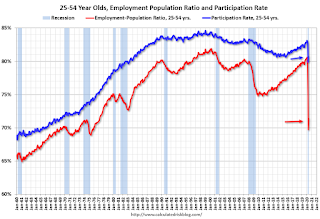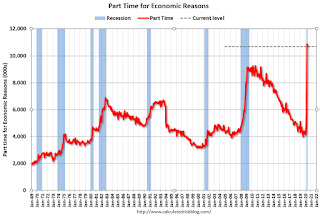by Calculated Risk on 6/05/2020 10:27:00 AM
Friday, June 05, 2020
Comments on May Employment Report
The May employment report was surprising. Every key indicator - ISM surveys, ADP employment report, unemployment claims and more - suggested further job losses in May. Instead the BLS reported job gains of 2.5 million (about 10 million better than consensus forecasts), and the unemployment rate decreased to 13.3%.
The reference week in May (includes the 12th) was too soon to be impacted by most areas "reopening". One possibility is that many companies brought back employees to qualify for the PPP (Payroll Protection Plan).
Earlier: May Employment Report: 2,500,000 Jobs Added, 13.3% Unemployment Rate
In April, the year-over-year employment change was minus 17.7 million jobs.
One of the keys to follow will be the number of workers on temporary layoff. This increased from 801 thousand in February, to 1.848 million in March, and to 18.063 million in April. This decreased by 2.7 million
in May to 15.343 million. It could be that companies let too many workers go in April and brought some back - or this might be related to PPP adjustments.
Prime (25 to 54 Years Old) Participation

Since the overall participation rate has declined due to cyclical (recession) and demographic (aging population, younger people staying in school) reasons, here is the employment-population ratio for the key working age group: 25 to 54 years old.
The prime working age will be key in the eventual recovery.
The 25 to 54 participation rate increased in May to 80.7%, and the 25 to 54 employment population ratio increased to 71.4%.
Part Time for Economic Reasons

"The number of persons employed part time for economic reasons, at 10.6 million, changed little in May, but is up by 6.3 million since February. These individuals, who would have preferred full-time employment, were working part time because their hours had been reduced or they were unable to find full-time jobs. This group includes persons who usually work full time and persons who usually work part time."The number of persons working part time for economic reasons decreased in May to 10.633 million from 10.887 million in April.
These workers are included in the alternate measure of labor underutilization (U-6) that decreased to 21.2% in May. This is down slightly from the record high last month for this measure (since 1994). The previous peak was 17.2% during the Great Recession.
Unemployed over 26 Weeks
 This graph shows the number of workers unemployed for 27 weeks or more.
This graph shows the number of workers unemployed for 27 weeks or more. According to the BLS, there are 1.164 million workers who have been unemployed for more than 26 weeks and still want a job. This will increase sharply in 4 or 5 months, and will be a key measure to follow during the eventual recovery.
Summary:
The headline monthly jobs number was surprising, and well above expectations. However, the previous two months were revised down significantly. The headline unemployment rate decreased to 13.3% (probably closer to 16% according to the BLS).
Since the reference week included the 12th of May, this was too soon to be impacted by "reopenings" in most areas. That will be more of a June story. Instead this increase in employment was likely due to companies rehiring because they let too many people go in April, and because some companies needed to rehire to qualify for PPP forgiveness.
As a reminder, the course of the economy will be determined by the course of the pandemic.


